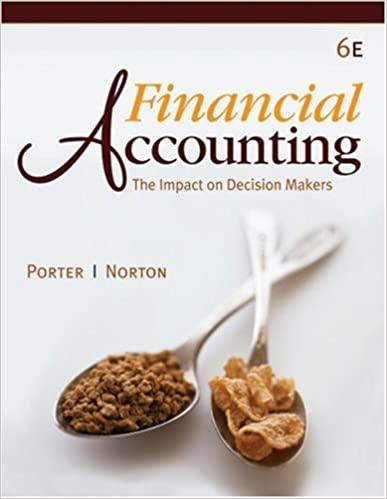Question
The financial statements for Royale and Cavalier companies are summarized here: Royale Company Cavalier Company Balance Sheet Cash $ 17,000 $ 80,000 Accounts Receivable, Net
The financial statements for Royale and Cavalier companies are summarized here:
| Royale Company | Cavalier Company | ||||||
| Balance Sheet | |||||||
| Cash | $ | 17,000 | $ | 80,000 | |||
| Accounts Receivable, Net | 47,000 | 8,000 | |||||
| Inventory | 94,000 | 9,000 | |||||
| Equipment, Net | 534,000 | 144,000 | |||||
| Other Assets | 132,000 | 38,000 | |||||
| Total Assets | $ | 824,000 | $ | 279,000 | |||
| Current Liabilities | $ | 104,000 | $ | 21,000 | |||
| Note Payable (long-term) | 174,000 | 39,000 | |||||
| Common Stock (par $20) | 472,000 | 202,000 | |||||
| Additional Paid-In Capital | 42,000 | 9,000 | |||||
| Retained Earnings | 32,000 | 8,000 | |||||
| Total Liabilities and Stockholders Equity | $ | 824,000 | $ | 279,000 | |||
| Income Statement | |||||||
| Sales Revenue | $ | 776,000 | $ | 256,000 | |||
| Cost of Goods Sold | 472,000 | 142,000 | |||||
| Other Expenses | 232,000 | 87,000 | |||||
| Net Income | $ | 72,000 | $ | 27,000 | |||
| Other Data | |||||||
| Per share price at end of year | $ | 18.00 | $ | 10.00 | |||
| Selected Data from Previous Year | |||||||
| Accounts Receivable, Net | $ | 39,000 | $ | 6,000 | |||
| Note Payable (long-term) | 174,000 | 39,000 | |||||
| Equipment, Net | 534,000 | 144,000 | |||||
| Inventory | 87,000 | 30,000 | |||||
| Total Stockholders' Equity | 546,000 | 219,000 | |||||
These two companies are in the same business and state but different cities. Each company has been in operation for about 10 years. Both companies received an unqualified audit opinion on the financial statements. Royale Company wants to borrow $67,000 cash and Cavalier Company is asking for $22,000. The loans will be for a two-year period. Both companies estimate bad debts based on an aging analysis, but Cavalier has estimated slightly higher uncollectible rates than Royale. Neither company issued stock in the current year. Assume the end-of-year total assets and net equipment balances approximate the years average and all sales are on account.
Required:
1. Calculate the following ratios. (Use 365 days in a year. Round your intermediate calculations and final answers to 2 decimal places.)
The financial statements for Royale and Cavalier companies are summarized here:
| Royale Company | Cavalier Company | ||||||
| Balance Sheet | |||||||
| Cash | $ | 17,000 | $ | 80,000 | |||
| Accounts Receivable, Net | 47,000 | 8,000 | |||||
| Inventory | 94,000 | 9,000 | |||||
| Equipment, Net | 534,000 | 144,000 | |||||
| Other Assets | 132,000 | 38,000 | |||||
| Total Assets | $ | 824,000 | $ | 279,000 | |||
| Current Liabilities | $ | 104,000 | $ | 21,000 | |||
| Note Payable (long-term) | 174,000 | 39,000 | |||||
| Common Stock (par $20) | 472,000 | 202,000 | |||||
| Additional Paid-In Capital | 42,000 | 9,000 | |||||
| Retained Earnings | 32,000 | 8,000 | |||||
| Total Liabilities and Stockholders Equity | $ | 824,000 | $ | 279,000 | |||
| Income Statement | |||||||
| Sales Revenue | $ | 776,000 | $ | 256,000 | |||
| Cost of Goods Sold | 472,000 | 142,000 | |||||
| Other Expenses | 232,000 | 87,000 | |||||
| Net Income | $ | 72,000 | $ | 27,000 | |||
| Other Data | |||||||
| Per share price at end of year | $ | 18.00 | $ | 10.00 | |||
| Selected Data from Previous Year | |||||||
| Accounts Receivable, Net | $ | 39,000 | $ | 6,000 | |||
| Note Payable (long-term) | 174,000 | 39,000 | |||||
| Equipment, Net | 534,000 | 144,000 | |||||
| Inventory | 87,000 | 30,000 | |||||
| Total Stockholders' Equity | 546,000 | 219,000 | |||||
These two companies are in the same business and state but different cities. Each company has been in operation for about 10 years. Both companies received an unqualified audit opinion on the financial statements. Royale Company wants to borrow $67,000 cash and Cavalier Company is asking for $22,000. The loans will be for a two-year period. Both companies estimate bad debts based on an aging analysis, but Cavalier has estimated slightly higher uncollectible rates than Royale. Neither company issued stock in the current year. Assume the end-of-year total assets and net equipment balances approximate the years average and all sales are on account.
Required:
1. Calculate the following ratios. (Use 365 days in a year. Round your intermediate calculations and final answers to 2 decimal places.)
Tests of Profitability:
Royale Company Cavalier Company
1. Net Profit Margin:
2. Gross Profit Margin
3. Fixed Asset Turnover
4. Return on Equity
5. Earnings per Share
6. Price/Earnings Ratio
Tests of Liquidity:
7. Receivables Turnover
Days to Collect
8. Inventory Turnover
Days to Sell
9. Current Ratio:
Tests to Solvency:
10. Debt-to-Assets:
Step by Step Solution
There are 3 Steps involved in it
Step: 1

Get Instant Access to Expert-Tailored Solutions
See step-by-step solutions with expert insights and AI powered tools for academic success
Step: 2

Step: 3

Ace Your Homework with AI
Get the answers you need in no time with our AI-driven, step-by-step assistance
Get Started


